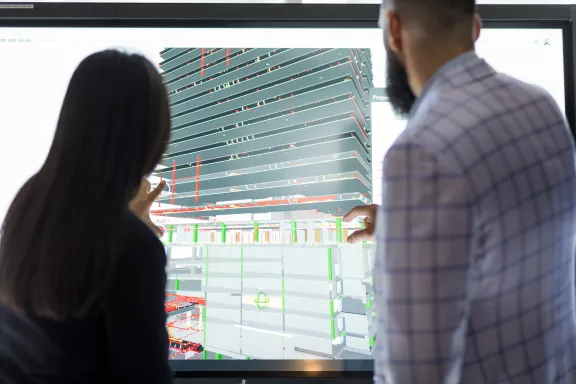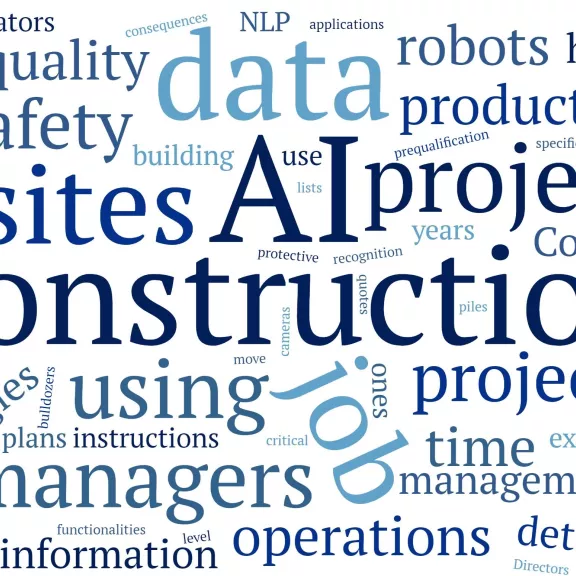

Nowadays, artificial intelligence is almost in every aspect of our daily lives. Our phones with targeted ads or tailored tweets, our smartwatch detecting our movement to estimate the consumed calories, our cars with lane detection or adaptive cruise control, all of them are using AI in various ways. AI is changing our lives as well as our work however for different jobs it is not the same change. In some industries with repetitive jobs, AI is replacing the human workforce and in the other ones like construction, there is still a long way ahead to fully automate some jobs. In this article, we review how AI-based innovations will affect different construction roles at different levels.
Laborers
It goes without saying that laborers are the engine of the construction industry. If laborers have higher or lower productivity, it simply means projects are progressing or delaying. So, what if AI could improve their productivity by providing smarter tools and work plans? Also, safety hazards are inseparable concerns in construction job sites and laborer’s lives can sometimes be at stake. AI can detect and predict hazardous events to minimize safety risks. Meanwhile, physical activities on construction project sites have different nature compared to operations in a factory. AI in the best application mode can facilitate laborers’ jobs and will not replace them for now.
Designers & Engineers
Architects and engineers are using various applications that benefit AI algorithms in the backend, on daily basis. However, in recent years generative models using parametric approaches are introduced to facilitate building layouts draft and comparison. Simulation software utilizes AI to replicate structural behavior, energy consumption, and users’ experience. AI is supporting building information modeling (BIM) in many ways to prevent design errors and match architectural plans with structural designs, MEPs, etc. AI cannot replace construction designers, but it leads to considerable transformations in automating repetitive tasks and increasing technical materials production.
Project Management
Construction projects involve many people from different expertise. AI can touch all of them to transform their daily jobs from description to prediction and prescription. Estimators can benefit the most from AI since large piles of historical data from previous projects can be processed by AI in a couple of hours to help them with tasks such as parametric estimating using statistical data, cost categorization, and cross-referencing cost data with estimates. Schedulers can count on AI in the same way to use predictive models and case-based reasoning algorithms to have more accurate time estimations. Altogether, with the help of AI, exhaustive bid preparation can be cheaper and faster by replacing estimators’ intuitional judgment with analytical models. AI analyses various quotes, vendor lists, tendering documents, and market trends and forecasts to help decision-makers in coming through a winning and profitable price.
Site Supervisors
Construction sites inherently include health and safety hazards and so many practices are instructed to minimize the incidents and create a safer working environment. Safety supervisors have limited time and resources to keep eye on the whole job site to make sure everyone is respecting safety instructions thoroughly. AI and computer vision can help them to supervise job sites and monitor compliance of necessary safety measures such as the use of private protective equipment (PPE), unauthorized intrusion detection, moving vehicles’ speed, and harmful posture recognition. Safety zones of machinery can be determined by AI and alarm the site personnel to prevent any stroke hazards. Any non-compliancy on the job site can be detected and reported to safety supervisors in real-time.
AI assists to detect and localize equipment and machinery in construction job sites using object detection algorithms. Moreover, material delivery and inventory management can be facilitated using AI models fed by data from cameras and other sensors. AI helps equipment operators to improve their productivity. For example, semi-automated bulldozers can get and send geotechnical coordination for excavation and prep works to help the operator through earthmoving or excavation operations. In the same way, AI-backed cranes enable crane operators to set a location and supervise the rest of the operation based on parameters like load weight, jib length, collision avoidance, wind speed, etc. which will be analyzed and determined by AI.
Surveyors and quality inspectors can rely on AI to accomplish most of their repetitive and time-consuming jobs. Autonomous robots are entering construction job sites and with the help of AI, robots collect data such as 3D scans and 360 images of the constructed elements of projects. Scans and visual data captured by drones or robots can be compared with 3D designs to monitor project progress and detect any divergences. Quality coordinators and managers are always involved in tedious paper works like reviewing project documents and subcontract details for specifications and requirements. AI using natural language processing (NLP) algorithms, can improve quality coordinators’ productivity and perform the job in a matter of minutes instead of days to extract required data and prepare quality turnover reports.
Managers and executives
Directors and managers need enough information for decision-making. High quality data can be gathered from job sites, market conditions, competitors, suppliers, etc., and be analyzed by AI to interpret and provide insightful information for managers. AI supports managers to move from descriptive and active management to prescriptive and proactive approaches. Some algorithms like “reinforcement learning” can search for various possible scenarios and study their consequences to come up with the best decision at the end. AI-backed dashboards can give a complete overview of the project portfolio with predictions for critical constraints such as cost and time and evaluate the risks of each project. AI can help executives in project selection while considering internal controls to avoid projects that bring long term challenges. AI algorithms like NLP can constantly mine news and information which are interesting for managers through the internet. AI can support managers and executives to have best practices in trend analysis, go/no go decisions, subcontractor prequalification and selection, and so many other aggregate-level decisions that can guarantee the long-lasting success of the organization.
Conclusion
The construction industry has always had a slow pace in adapting to new technologies. However, in recent years more companies are realizing the benefits of AI in the management of their projects. In contradiction to the operations in an assembly line of a factory, construction tasks and operations are more volatile and unlikely to be automated anytime soon. Although it is believed that construction jobs are safe from the employment impact of artificial intelligence, skill transformation in various job roles and functionalities is unavoidable. It is required to provide construction workers with new pieces of training and upskill them to operate, supervise, and maintain new technologies including AI. Meanwhile, AI enables managers and directors to catch up with the increasing complexity of construction projects and keep competitive advantages in the market.

